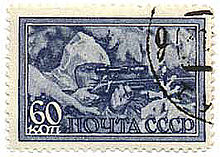Lyudmila Pavlichenko
Lyudmila Mykhailivna Pavlichenko Людмила Михайлівна Павліченко | |
|---|---|
| File:LudmilaPavlichenko.jpg Lyudmila Pavlichenko | |
| Allegiance | Soviet Union |
| Service | Red Army |
| Years of service | 1941 – 1953 |
| Rank | Major |
| Unit | 25th Infantry Division |
| Battles / wars | World War II Battle of Odessa Battle of Sevastopol |
| Awards | Order of Lenin Hero of the Soviet Union |
| Other work | Soviet Committee of the Veterans of War |
Lyudmila Mykhailivna Pavlichenko (Template:Lang-uk; Template:Lang-ru Lyudmila Mikhailovna Pavlichenko) (July 12, 1916 – October 10, 1974) was a Soviet sniper during World War II, credited with 309 kills, and is regarded as the most successful female sniper in history.[1]
Early life
Born in Bila Tserkva on July 12, 1916, Pavlichenko moved to Kiev with her family at the age of fourteen. There she joined a shooting club and developed into a sharpshooter, while working as a grinder at the Kiev Arsenal factory.[2] In 1937 as a student of Kiev University she successfully defended her master-thesis on Bohdan Khmelnytsky.[3]
World War II
In June 1941, 24-year old Pavlichenko was in her fourth year of studying history at the Kiev University when Nazi Germany began its invasion of the Soviet Union[2]. Pavlichenko was among the first round of volunteers at the recruiting office, where she requested to join the infantry and subsequently she was assigned to the Red Army's 25th Rifle Division[2]; Pavlichenko had the option to become a nurse but refused "I joined the army when woman were not yet accepted"[2]. There she became one of 2,000 female snipers in the Red Army, of whom about 500 ultimately survived the war. As a sniper, she made her first two kills near Belyayevka[3], using a Mosin-Nagant bolt action rifle with a P.E. 4-power scope.

Pvt. Pavlichenko fought for about two and a half months near Odessa, where she recorded 187 kills.[3] When the Germans gained control of Odessa, her unit was pulled to be sent to Sevastopol on the Crimean Peninsula[3], where she fought for more than 8 months.[4][2] In May 1942, Lieutenant Pavlichenko was cited by the Southern Army Council for killing 257 German soldiers. Her total confirmed kills during World War II was 309[2], including 36 enemy snipers.
In June 1942, Pavlichenko was wounded by mortar fire. Because of her growing status, she was pulled from combat less than a month after recovering from her wound.

Pavlichenko was sent to Canada and the United States for a publicity visit and became the first Soviet citizen to be received by a U.S. President when Franklin Roosevelt welcomed her at the White House. Later, Pavlichenko was invited by Eleanor Roosevelt to tour America relating her experiences. While meeting with reporters in Washington, D.C. she was dumbfounded about the kind of questions put to her "One reporter even criticized the length of the skirt of my uniform, saying that in America women wear shorter skirts and besides my uniform made me look fat".[1][5] Pavlichenko appeared before the International Student Assembly being held in Washington, D.C., and later attended CIO meetings and made appearances and speeches in New York City. The United States gave her a Colt automatic pistol, and in Canada, she was presented with a sighted Winchester rifle, the latter of which is now on display at the Central Armed Forces Museum in Moscow. While visiting in Canada along with Vladimir Pehelintsev (fellow sniper) and Nikolai Krasavchenko (Moscow fuel commissioner), they were greeted by thousands at Toronto's Union Station.
Having attained the rank of Major, Pavlichenko never returned to combat but became an instructor and trained Soviet snipers until the war's end[2]. In 1943, she was awarded the Gold Star of the Hero of the Soviet Union, and was commemorated on a Soviet postage stamp.
After the War
After the war, she finished her education at Kiev University and began a career as a historian. From 1945 to 1953, she was a research assistant of the Chief HQ of the Soviet Navy. She later was active in the Soviet Committee of the Veterans of War.[2]
American folk musician Woody Guthrie recorded a song in 1946 entitled "Miss Pavlichenko" as a tribute to her kill record, believed to have been written in late 1942. It was released as part of the Asch Recordings.[6]
Pavlichenko died on October 10, 1974 at age 58, and was buried in the Novodevichye Cemetery in Moscow.[2]
In 1976, she was commemorated on a second Soviet postage stamp, and a Ukrainian cargo ship was named in her honor.[citation needed]
See also
References
- ^ a b Lady Sniper, TIME Magazine (Monday, September 28, 1942)
- ^ a b c d e f g h i Heroines of the Soviet Union 1941-45 by Henry Skaida, Osprey Publishing, 2003, ISBN 1841765988/ISBN 978-1841765983, page 31
- ^ a b c d Women and War: A Historical Encyclopedia from Antiquity to the Present by Arthur Bernard Cook, ABC-CLIO, 2006, ISBN 1851097708/ISBN 978-1851097708, page 457
- ^ Template:Ru icon 1Павличенко Людмила Михайловна, Country's Heroes (warheroes.ru)
- ^ The World War Two Reader by Gordon Martel, Routledge, 2004, ISBN 0415224039/ISBN 978-0415224031, page 268
- ^ Hard Travelin': The Asch Recordings, Vol. 3, Amazon.com
